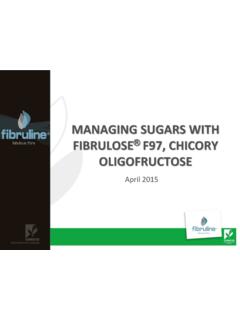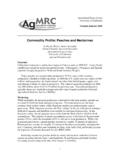Transcription of Assessment report on Arctium lappa L., radix
1 7 Westferry Circus Canary Wharf London E14 4HB United Kingdom Telephone +44 (0)20 7418 8400 Facsimile +44 (0)20 7523 7051 E-mail Website An agency of the european union european Medicines Agency, 2011. Reproduction is authorised provided the source is acknowledged. 16 September 2010 EMA/HMPC/246764/2009 Committee on Herbal Medicinal Products (HMPC) Assessment report on Arctium lappa L., radix Based on Article 16d(1), Article 16f and Article 16h of Directive 2001/83/EC as amended (traditional use) Final Herbal substance(s) (binomial scientific name of the plant, including plant part) Arctium lappa L., radix Herbal preparation(s) a) Comminuted herbal substance b) Powdered herbal substance c) Liquid extract (DER 1:1), extraction solvent ethanol 25% V/V d) Soft extract1, extraction solvent water e) Tincture (ratio of herbal substance to extraction solvent 1:10), extraction solvent ethanol 45% V/V f) Tincture (ratio of herbal substance to extraction solvent 1:5), extraction solvent ethanol 25% V/V Pharmaceutical forms Comminuted herbal substance as herbal tea for oral use.
2 Herbal preparations in solid or liquid dosage forms for oral use. Rapporteur Gert Laekeman Assessors Kristien Fonteyne, B n dicte Van Baelen 1 Codex Fran ais 1949 Assessment report on Arctium lappa L., radix EMA/HMPC/246764/2009 Page 2/26 Table of contents Table of 2 1. 3 Description of the herbal substance(s), herbal preparation(s) or combinations Information about products on the market in the Member 7 2. Historical data on medicinal 10 Information on period of medicinal use in the 10 Information on traditional/current indications and specified Specified strength/posology/route of administration/duration of use for relevant preparations and 12 3. Non-Clinical 15 Overview of available pharmacological data regarding the herbal substance(s), herbal preparation(s) and relevant constituents 15 Overview of available pharmacokinetic data regarding the herbal substance(s), herbal preparation(s) and relevant constituents 19 Overview of available toxicological data regarding the herbal substance(s)/herbal preparation(s) and constituents 21 Overall conclusions on non-clinical 21 4.
3 Clinical 22 Clinical 22 Overview of pharmacodynamic data regarding the herbal substance(s)/preparation(s) including data on relevant 22 Overview of pharmacokinetic data regarding the herbal substance(s)/preparation(s) including data on relevant 22 Clinical 22 Dose response 22 Clinical studies (case studies and clinical trials).. 22 Clinical studies in special populations ( elderly and children).. 22 Overall conclusions on clinical pharmacology and 22 5. Clinical 23 Overview of toxicological/safety data from clinical trials in 23 Patient 23 Adverse events and serious adverse events and 23 Laboratory 24 Safety in special populations and 24 Overall conclusions on clinical 25 6. Overall 25 Assessment report on Arctium lappa L., radix EMA/HMPC/246764/2009 Page 3/26 1. Introduction Description of the herbal substance(s), herbal preparation(s) or combinations thereof Botanical description Arctium lappa L.
4 Is known under the synonyms: Latin: Arctium majus BERNH., lappa communis var. major COSSON et GERM., lappa major GAERTN., lappa officinalis ALL., lappa vulgaris HILL., lappa vulgaris var. major NEILR English: beggars button, burdock, cockle-bur, cockle-button, common burdock, cuckold-dock, great but, great clotbur, greater burdock, hardock, hare burr, hurr-bur, stick-button, bat weed French: bardane, bouillon noir, choux d nes, glouteron, gouteron, grande bardane, grateau, grateron, herbe aux pouilleux, herbe aux teigneux, oreille de g ant, pignet, teigneux German: gro e Klette, Dollenkraut, gemeine Klette Italian: bardana, bardana maggiore, farfariaccio, lappa bardana, lappola Dutch: grote klis, grote klit, dokke, kladden, klevers, Jan-plak-an Japanese: gobo (Blaschek 1998, Delfosse 1998, De Smet 1993, Leclerc 1966, Van Os 1980, Wichtl 1994). Arctium lappa L. is a biennial member of the Compositae (Asteraceae) that can reach one meter and a half.
5 It has large cordiform leaves. The purple flowers appear from July until September. The spherical flower head, three to four centimeters in diameter, has rough hairs (Delfosse 1998, Lambinon 1998). Native in Europe, Northern Asia and North America (Wichtl 1994). Herbal substance(s) Folium The leaves are collected from 1-year old plants and dried (Blaschek 1998). The use of fresh leaves is described in literature (Leclerc 1966, Valnet 2001). Constituents: - Sesquiterpenes: The dried leaves contain essential oil, arctiol, dehydrofukinone, eremophilene, -eudesmol, fukinanolide, fukinone and petasitolone. The fresh leaves contain onopordopicrin and the ground leaves arctiopicrin. - Triterpenes: Free terpene alcohols, free sterols, triterpene esters. From the petrolether extract of dried leaves are isolated: free triterpene alcohols ( -amyrine, -amyrine, lupeol, phytol, -taraxasterol, taraxasterol), triterpene alcohol acetates (taraxasterol acetate, -amyrine acetate, -amyrine acetate, lupeol acetate, -taraxasterol acetate) triterpene alcohol esters with long chain fatty acids (taraxasterolester, -amyrine ester, -amyrine ester, lupeolester, phytolester, -taraxasterolester).
6 - Fatty Acids: saturated (C14 - C26) and unsaturated (C18) fatty acids. - Phenol Carbonic Acid: Caffeic acid. - Ascorbic Acid, -Mucilage, Tannins. Assessment report on Arctium lappa L., radix EMA/HMPC/246764/2009 Page 4/26 (Blascheck 1998). Semen (fructus) The mature fruit is collected in autumn and dried. Thereafter, the dried fruit is purified and dried again in the sun (Blaschek 1998). The dried, ripe fruit is collected in autumn (Chinese Pharmacopoeia 1995, K rfers 2009). Constituents: - Fatty Oils: The seeds contain about 16% fatty oils, namely linoleic acid, oleic acid, octadecatrienic acid, palmitic acid, stearic acid, eicosatrienic acid, arachidonic acid, myristinic acid, linolenic acid, heptadecanic acid, margarinic acid and pentadecanic acid. - Lignans: The fruit contains a broad spectrum of lignans. Lignans with two phenylpropane units: arctiin, arctigenin, matairesinol. Lignans with three phenylpropane units ( sesquilignans ): lappaol A, lappaol B, lappaol C, lappaol D, lappaol E.
7 Lignans with four phenylpropane units ( dilignans ): lappaol F, lappaol H, neoarctin A, neoarctin B and diarctigenin. - Daucosterol (fruit). radix The most recent official definition is included in DAC 2008: dried, total or cut roots of Arctium lappa L. (=A. major Gaertn.), A. minus (Hill) Bernh., A. tomentosum Mill. (Asteraceae) and from related species, hybrids or mixtures thereof. The root is collected in the autumn of the first year or in the spring of the second year. Similar or identical definitions can be found in Barnes (2007), Blaschek (1998), De Smet (1993), Duke (1988), Uchiyama (2005) and Wichtl (1994). Constituents: - Volatile constituents, essential oil: There are only of essential oil in the roots of Arctium lappa L., altough this fraction is well investigated. More than 60 subclasses are known. Blaschek (1998) categorizes them as follows: Aliphatic hydrocarbons: aplotaxen, dihydroaplotaxen, 1-heptadecen, 1-pentadecen Aliphatic and aromatic aldehydes: phenylacetaldehyde, propionaldehyde, benzaldehyde, butyraldehyde, caproicaldehyde, isovaleraldehyde and others Carbonic acids: carbonic acids from C2 until C13 and also tiglic acid, isovaleric acid among others Pyrazines: 2-methoxy-3-methylpyrazin and six other 2-alkyl (C3-C5)-3-methoxypyrazines Sesquiterpenes: -guajen, cyperen, costic acid, dehydrocostuslacton CH2 OOCH2CH2 Figure 1: dehydrocostuslacton - Lappaphenes: Lappaphen-a and lappaphen-b are isolated from the fresh root.
8 - Sulfur-free polyacetylenes: The polyacetylenes percentage is higher in a fresh root than in a dried root. More than ten different polyacetylenes can be identified. 1,11-tridecadiene-3,5,7,9-tetrayne is the most important one. Figure 2: 1,11-tridecadiene-3,5,7,9-tetrayne - Sulfur-containing polyacetylenes (thiophenes): arctinal, arctinol A, arctinol B, arctinon-A, arctinon-B, arctinon-A-acetaat, arctic acid B, arctic acid C and arctic acid-B-methylester have been isolated. SSCH3 OHOH Figure 3: arctinol - Phenolcarbonic acids and tannins: The fresh root contains up to polyphenols with chlorogenic acid, isochlorogenic acid and caffeic acid. More recent tests show the presence of derivatives of quinic acid. The root also contains a small amount of tannins. - Lignans: neoarctin A and the lignanolide arctiin. Assessment report on Arctium lappa L., radix EMA/HMPC/246764/2009 Page 5/26 OOHOOMeOMeMeO Figure 4: arctiin - Triterpenes: triterpenester, free sterols (sitosterol, stigmasterol, ), , triterpenacetates, triterpenacids and triterpenalcohols ( -amyrine, -amyrine, lupeol, -taraxasterol, phytol) are isolated from the petrolether extract of the dried root.
9 - Fatty acids: until fatty acids including linolenic acid, linoleic acid, myristic acid, palmitic- and stearic-acids - Polysaccharides: The total carbohydrates may represent up to 70% of the dry mass and contain mainly inulin (about 45%). - Other constituents: The aminoacid fraction contains -guanidino-n-butyric acid. Also vitamin C (23 mg/100 g) has been found. - Baicalin OOOOHOHOHOHOHOOHOF igure 5: baicalin - Aplotaxene Figure 6: aplotaxene Herbal preparation(s) Apart from the references cited, market information was included (Barnes 2007, Blaschek 1998, Delfosse 1998, Leclerc 1966, Valnet 2001, Van Hellemont 1985). Assessment report on Arctium lappa L., radix EMA/HMPC/246764/2009 Page 6/26 Assessment report on Arctium lappa L., radix EMA/HMPC/246764/2009 Page 7/26 Hagers Handbuch der Pharmazeutischen Praxis (Blaschek 1998) mentions different fluid extracts of radix Bardanae (Extractum Bardanae): - Extractum Bardanae Portug.
10 - Extractum Bardanae Brasil. - Extractum lappae fluidum - Extractum lappae fluidum Brasil. - Extractum lappae majoris stabilisatae No further details could be retrieved for those preparations. Combinations of herbal substance(s) and/or herbal preparation(s) including a description of vitamin(s) and/or mineral(s) as ingredients of traditional combination herbal medicinal products assessed, where applicable. Essiac is described as a formula that consists of four herbal substances: Arctium lappa L., Rheum palmatum L., Rumex acetosella L. and Ulmus rubra L. The preparation is only partially characterised. Indication: cancer treatments but no convincing clinical evidence is available (Capasso 2003, Ulbricht 2009). Information about products on the market in the Member States Regulatory status overview Member State Regulatory Status Comments Austria MA TRAD Other TRAD Other Specify: No authorized or registered preparations Belgium MA TRAD Other TRAD Other Specify: No authorized or registered preparations Bulgaria MA TRAD Other TRAD Other Specify: No authorized or registered preparations Cyprus MA TRAD Other TRAD Other Specify: No information Czech Republic MA TRAD Other TRAD Other Specify: Only combination products Denmark MA TRAD Other TRAD Other Specify: Only combination products Estonia MA TRAD Other TRAD Other Specify: Only food supplements Finland MA TRAD Other TRAD Other Specify: No information France MA TRAD Other TRAD Other Specify: Registered products on the market since 1980 Germany MA TRAD Other TRAD Other Specify.













